ANGUS CATTLE EVALUATION

December 2024

Acknowledgements


December 2024

Acknowledgements
December 2024
Dear Angus Breeders,
This document includes details of the 2024 annual enhancements for inclusion in the TransTasman Angus Cattle Evaluation (TACE). The enhancements are scheduled for implementation in the December 2024 analysis, being the analysis where the Estimated Breeding Values (EBVs) are released on approximately November 29th, 2024.
The annual enhancements that are made to TACE ensure that the EBVs published for Angus animals continue to be the best possible estimate of an animal’s breeding value, maximising the genetic improvement that is being achieved in Angus breeding programs.
The enhancements scheduled for implementation in 2024 broadly fall into three categories:
Please contact staff at Angus Australia if you have any questions. A list of contacts is provided on page 6.
Regards

Scott Wright

Christian Duff Chief Executive Officer General Manager Genetic Improvement
The enhancements to the TransTasman Angus Cattle Evaluation are the result of both internal R&D capability and considerable collaboration with livestock genetics research and service delivery organisations. For several of the 2024 Enhancements Angus Australia
to extend our thanks and gratitude to:
The Animal Genetics & Breeding Unit (AGBU), in particular Dr Steve Miller, Dr Andrew Swan, Dr Natalie Connors, Dr Brad Walmsley and Christian Girard.
The Agricultural Business Research Institute (ABRI), in particular Dr Brad Crook and Nicky Turner.
The School of Environmental and Rural Science, University of New England, in particular Professor Sam Clark and Dr Hassan Aliloo
Angus Australia has a long history of enhancing and expanding the range of Estimated Breeding Values (EBVs) from the TransTasman Angus Cattle Evaluation (TACE). This ensures the genetic evaluation is providing information on breeding candidates (i.e. bulls, cows, heifers) that is relevant to modern beef cattle programs. Importantly this focuses on traits that are considered important to the breeding objectives of Australian and New Zealand producers.
When TACE commenced in the lates 1980’s (as Angus Group BREEDPLAN), the analysis initially included 6 EBVs being Birth Weight, 200 Day Weight, 400 Day Weight, 600 Day Weight and Milk. Today, 22 EBVs, 6 Research Breed Values (RBVs) and 10 Selection Indexes are published from TACE. The EBVs and RBVs cover the broad areas of calving ease, growth, fertility, carcase, temperament, feed efficiency, structural soundness, resilience and eating quality.
The following two developments focus on the enhancement of EBVs within the TransTasman Angus Cattle Evaluation.
1.1 Transition of Cow Body Composition RBVs to EBVs
Key Points:
· Mature Body Condition and Mature Cow Height RBVs have been transitioned to EBVs.
· They join the suite of Maternal EBVs including Mature Cow Weight and Milk.
· Members have responded to the “Breed Better Breeders” project by recording more body condition scores, hip heights and weights on the cow herd.
· Mature cow body condition is a different trait genetically to ultrasound scan and carcase rib or rump fats, with genetic correlations ranging from 0.08 to 0.35.
Angus Australia has been publishing Mature Body Condition (MBC) and Mature Cow Height Research Breeding Values (RBVs) for over 5 years. This started from regular member feedback asking for further genetic understanding of traits related to the productivity and profitability of the Angus cow herd. From this feedback, a collaborative project was developed with the University of New England known as “Breeding Better Breeders”, with the main output being the publication of the cow body composition traits, the MBC and MCH RBVs, as part of the routine TACE evaluation.
In the December 2023 TACE Enhancements, the model and parameters used to generate the MBC and MCH RBVs were

enhanced significantly with the keys point being;
1. Significantly more animals display the Mature Body Condition and Mature Cow Height RBVs
2. The variance components, including the heritabilities, for both traits where re-estimated, and
3. Genomics was included through a single step evaluation model for both RBVs.
Based on the 2023 enhancements which ramped the evaluation up to ‘state-of-the-art’, and the response from members in recording significantly more weights, body condition scores and hip heights on their cow herds (figure 1), the MBC and MCH RBVs have been transitioned to EBVs.
With the transition to EBV status, the evaluation for these traits remains the same, but they are now reported consistently with other EBVs. This includes in the animal listings, tables and graphs on angus.tech (figure 2) and listed in the relevant herd specific reports and files (TACE Herd EBV report, EBV extended file, Genetic Benchmarking Report) produced at each TACE evaluation.
As a reminder, for interpretation:
· Mature Cow Body Condition (MBC) EBVs provide estimates of genetic differences between animals in the body condition of mature females. Mature Cow Body Condition EBVs are calculated from a subjective assessment of an animal body condition and are expressed in score units. Higher Mature Body Condition EBVs indicate an animal is expected to produce daughters with more body condition as mature females.


Mature Cow Height (MCH) EBVs provide estimates of genetic differences between animals in the height of mature females Mature Cow Height EBVs are calculated from height measurements taken at the hip and are expressed in cm units. Higher Mature Cow Height EBVs indicate an animal is expected to produce daughters that are taller as mature females.
Further information on understanding the MBC and MCH EBVs, and EBVs in general, is available from the Angus Education centre (https://www.angusaustralia.com.au/education)
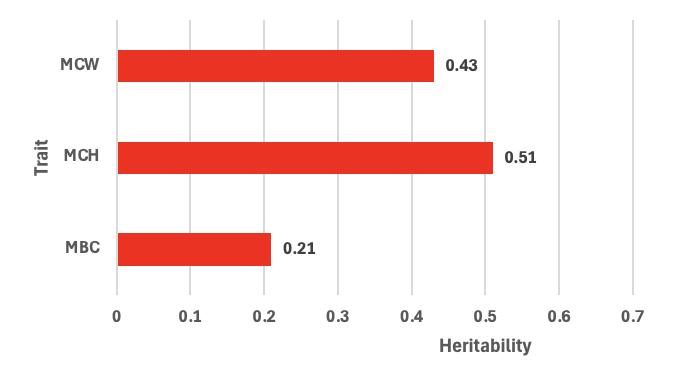
3. Heritability of Mature Cow Weight (MCW), Mature Body Condition (MBC) and Mature Cow Height (MCH).
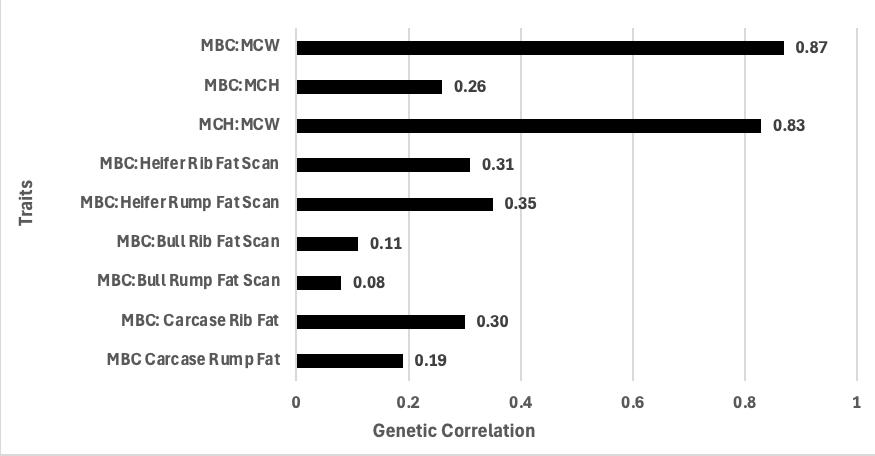
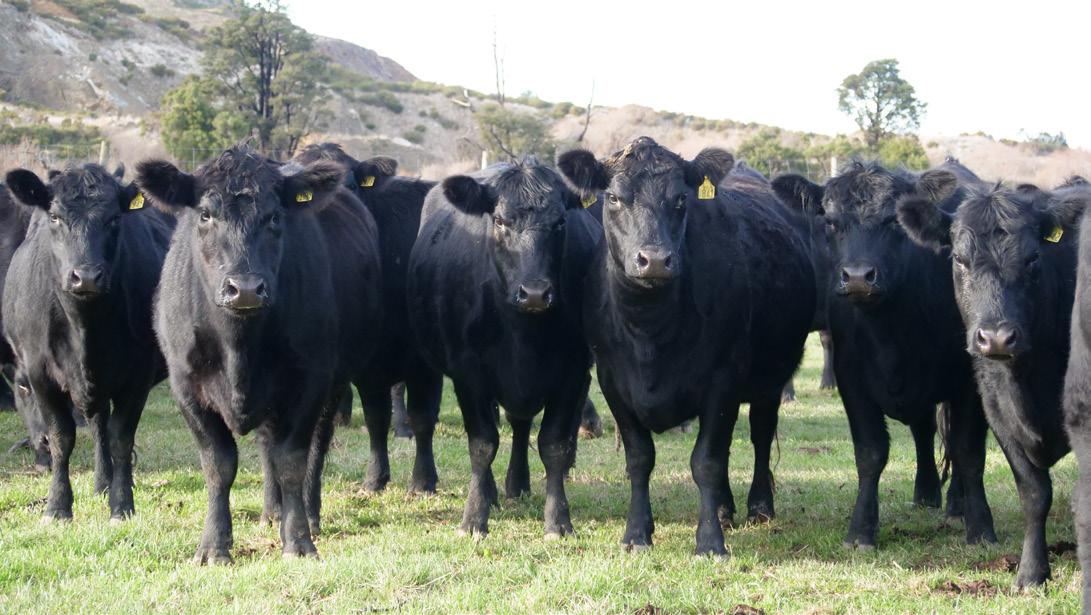
a correlated effect by selecting on the carcase fat EBVs. It also means that Angus producers can select to move the traits (cow body condition and steer carcase fat) in different directions if beneficial to the breeding objective.
Key Points:
· The descriptions on the percentile graphs for the three structural soundness EBVs (Claw Set, Foot Angle and Leg Angle) have been modified to make their interpretation more intuitive.
· The model used to calculate the Structural Soundness EBVs remains unchanged. ·
To make interpretation more intuitive, the descriptions on the percentile graphs (figure 5) for the three structural soundness EBVs (Claw Set, Foot Angle and Leg Angle) have been modified. They have been changed from ‘higher score’ and ‘lower score’, which is related to the associated beef class structural assessment scoring system, to more descriptive language associated with what can be expected in the way of progeny
1. Modified EBV Percentile Description for the Structural Soundness EBVs.
The genetic parameters for the MBC and MCH traits were recently calculated and reviewed, and is a large part the reason for the transition from RBVs to EBVs. The traits are heritable (figure 3), and the estimates are consistent with prior similar studies on similar traits. Furthermore, in relation to the fat traits, the genetic correlations (figure 4) show that MBC is genetically a very different trait compared to the bull and heifer fat ultrasound scans and steer carcase fat measurements. This means that more genetic progress or change can be made to cow herd body condition through direct selection, rather than via
differences, as described in Table 1:
Like all TACE EBVs, Angus producers are encouraged to consider the Structural Soundness EBVs in the context of an overall breeding objective for their herd. This includes deciding, if a trait is included in the breeding objective, which direction to select to benefit your herd, rather than assuming a higher percentile value is always preferable.

Angus Australia publishes a range of Selection Indexes to cover the many scenarios in which Angus genetics are utilised across Australia and New Zealand. This is in line with the “Angus for Every System” vision for Angus Australia.
Selection Indexes, in the context of livestock genetic evaluation, aid in the selection of breeding animals where there are several traits of economic or functional importance by providing an overall “score” of an animal’s genetic value. They are derived for a specific breeding system and are calculated based on weightings placed on individual traits that are deemed to be important for that system, usually based on a bio-economic model.
As part of the 2024 TACE Enhancements, Angus Australia has included an additional Selection Index for the Angus of Dairy production system.
Key Points:
· Angus Australia is now publishing an Angus on Diary (AOD) Research Index.
· The AOD Index has been initially released as a Research Index for further Industry consultation.
· The AOD can be accessed via angus.tech database search or a quarterly Sire Report.
For the past 12-month Angus Australia has been interacting with the Australian Dairy sector to gauge interest on providing genetic information on Angus animals tailored for the Beef on Dairy supply chain. As a result of the strong interest, Angus Australia has recently developed an Angus on Dairy Research Index. Coupled with feedback from the Dairy sector, the development was undertaken in collaboration with the Animal Genetic and Breeding Unit (AGBU) via the BREEDPLAN pipeline. This development specifically utilised the BreedOBJECT software.
The Angus on Dairy Index has initially been released as a Research Index to enable further industry consultation.
The Angus on Dairy Research Index ($AOD) is designed for situations where Angus bulls are being used as a terminal sire over milking dairy cows, and all progeny, both male and female, are slaughtered. It focuses on calving ease, growth, carcass yield and eating quality. Daughters are not retained for breeding and
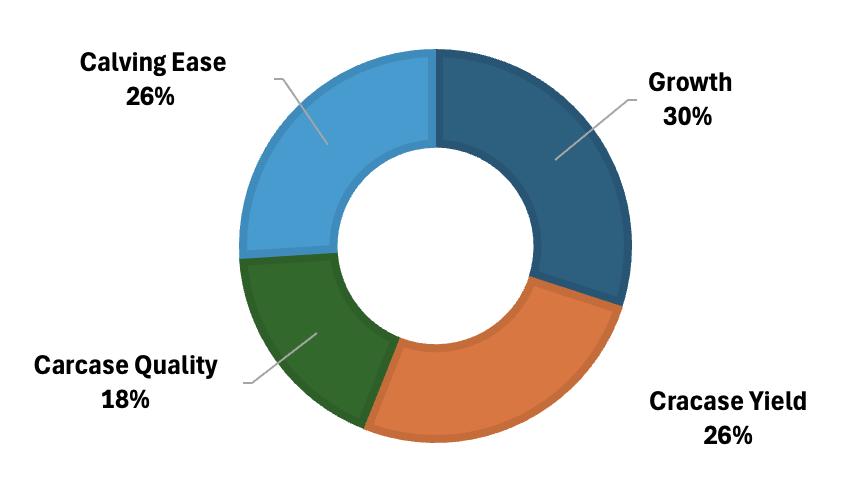
therefore no emphasis is given to fertility or maternal traits.
Figure 6 shows the traits that are considered in the $AOD Research index, and how much they contribute to the overall balance of the index. The larger the segment, the greater the impact on the selection index.
Figure 7 shows the selection advantage if animals are selected using the $AOD Index.
The selection advantage is calculated by ranking well used sires within the Angus breed on the $AOD index and comparing the average EBVs of the sires in the highest 10% with the average EBVs of all sires from which they were selected. For example, the sires ranked in the highest 10% based on the $AOD index had a 1.1kg lighter Birthweight EBV and a 13.4kg higher 400 Day Weight EBV than the average EBVs of the sires from which they were selected.
The selection advantage is indicative of the relativity of response that will occur in individual traits if selection is based on the $AOD index. The actual response that is observed will vary depending on the features of the individual breeding program.
The Angus of Dairy Research Index is accessible from angus. tech database search on all animals involved in TACE. It will be published in the same location as the current Selection Indexes (i.e. customised results layout, Selection Indexes tab). Animals can also be searched for or sorted on the Angus on Dairy Index, like the other EBVs, RBV and Selection Indexes. A specific Angus on Dairy Research Index sire report will also be published 4 times per year, in line with the publication of the Angus Sire Summary.
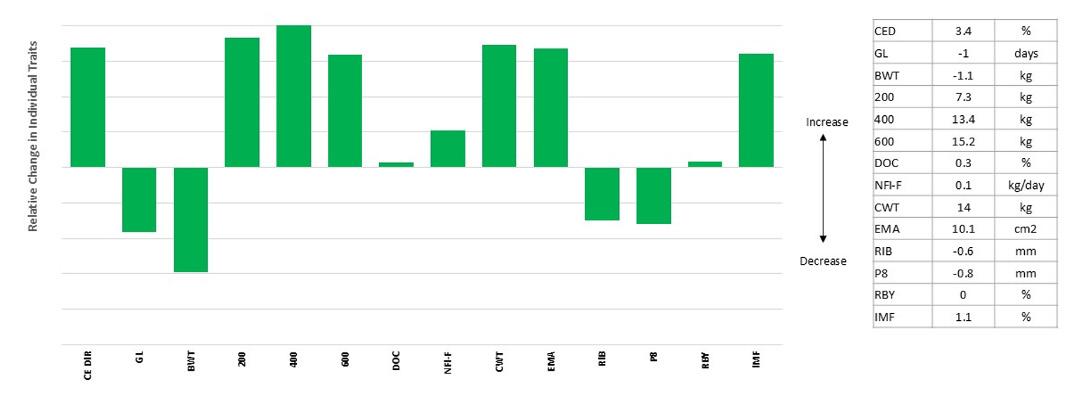

In addition to the enhancements noted above, several other enhancements will also be implemented. These enhancements form an important part of the ongoing maintenance of the TransTasman Angus Cattle Evaluation model and data pipeline.
Key Points:
· A revised genomics exclusion process has been implemented with a pragmatic approach to handling duplicate (DG) and sex (SX) inconstancies.
· Adjustment have been made in the single step evaluation model from the BREEDPLAN pipeline to improve the alignment of pedigree and genomic relationships.
· EBVs and Selection Indexes may change for individuals arising from the enhancements to Genetic Evaluation model and pipeline.
Within the BREEDPLAN pipeline of TACE, a comprehensive quality assurance (QA) procedure is undertaken at each analysis to ensure the genotypes included are suitable for the genetic evaluation. This includes checking for duplicate genotypes, parentage mismatches and an animal’s relationship to the reference population, to name but a few. Genotypes that are excluded during the QA procedure are reported back to members in the TACE Exclusions report in line with the fortnightly TACE schedule
Following a review of the genomics exclusions process, the following pragmatic changes will be implemented as part of the 2024 annual enhancements:
Duplicate genotypes from obvious twins (same sire, dam, birth date) will be automatically included in the genetic evaluation. These are currently reported in the TACE Exclusions report for with a DG exclusion code.
Genotypes from animals with a sex inconsistency (i.e. different recorded sex to genotype predicted sex) will also be automatically included in the genetic evaluation. These are currently reported in the TACE Exclusions report for with a SX exclusion code.

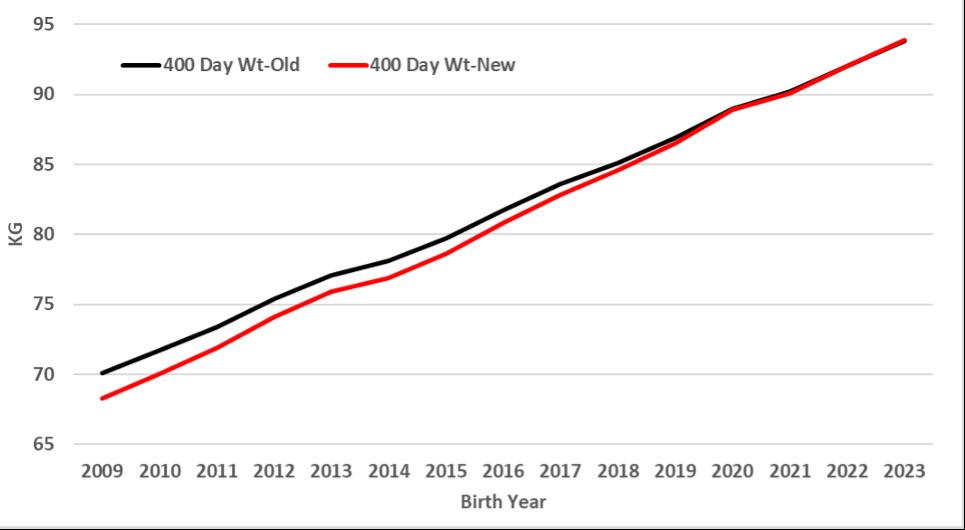
The changes listed above will be applied to all (old, new and future) animals and their genotypes in the evaluation. This will result in approximately 1,500 previously excluded genotypes now being included in the December 2024 TACE for the first time. The EBVs and Selection Indexes for the animals with a genotype analysed for the first time are expected to change.
Additionally, the member TACE exclusions report has been modified to include a new section which lists animals with a duplicate (DG) or sex (SX) inconsistences, that have been automatically included in TACE. This is so members can check and advise Angus Australia if further action is required.
This enhancement involves an adjustment in the single step evaluation model from the BREEDPLAN pipeline to improve the alignment of pedigree and genomic relationships. Within the single-step model both pedigree and genomic relationship are used to generate EBVs.
The impact of this alignment is mainly seen in the long-term genetic trends, and results from the fact that most of the genotyping has occurred in recent generations, with pedigree only information available in the pre-genomics era (figure 8). The main observation is that genetic trends across the TACE population have generally increased. While the EBVs and Selection Indexes of the current generation look similar, the yearon-year genetic trend (e.g. change in average EBV or Selection Index by birth year) have increased over time, which better reflects the actual genetic progress achieved. An example of this comparing the genetic trend based on the TACE 400 day weight EBV is shown in figure 9.
The impact on breeding programs is expected to be minimal, because the ranking of animals within cohorts (i.e. year groups) will only see minimal change, with correlations between EBVs or Selection indexes with and without the enhancement typically greater than 0.97. That said, the implementation of this enhancement will explain some changes to EBVs observed when the annual enhancements are implemented.
To further discuss any of the enhancements implemented in the December 2024 TransTasman Angus Cattle Evaluation, please contact members of Angus Australia’s Genetic Improvement and Extension team.
Nancy Crawshaw
Acting Extension Manager
Ph: +61 2 6773 4643
E: nancy.crawshaw@angusaustralia.com.au
Hanlie Jansen
Extension Officer
Ph: +61 2 6773 4641
E: hanlie.jansen@angusaustralia.com.au
Christian Duff General Manager - Genetic Improvement
Ph: +61 2 6773 4620
E: christian@angusaustralia.com.au
www.angusaustralia.com.au
